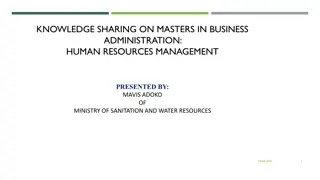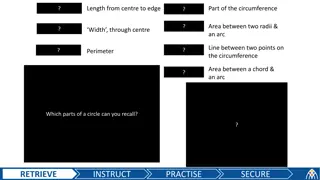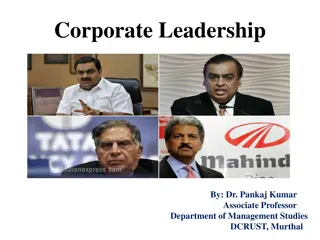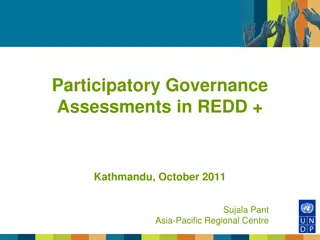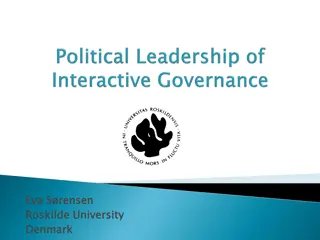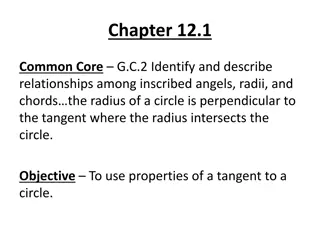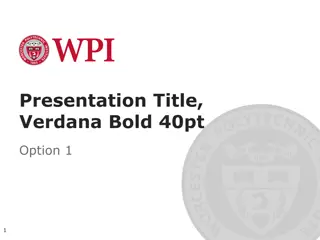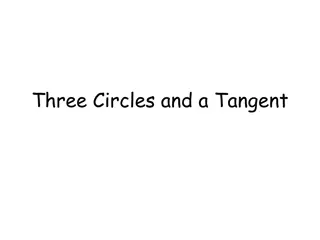Leadership Styles in Governance Circles
The session explores various leadership styles such as autocratic, democratic, and laissez-faire, emphasizing their impact on organizational dynamics. It delves into the merits and disadvantages of each style to provide a comprehensive understanding of effective leadership.
Download Presentation

Please find below an Image/Link to download the presentation.
The content on the website is provided AS IS for your information and personal use only. It may not be sold, licensed, or shared on other websites without obtaining consent from the author.If you encounter any issues during the download, it is possible that the publisher has removed the file from their server.
You are allowed to download the files provided on this website for personal or commercial use, subject to the condition that they are used lawfully. All files are the property of their respective owners.
The content on the website is provided AS IS for your information and personal use only. It may not be sold, licensed, or shared on other websites without obtaining consent from the author.
E N D
Presentation Transcript
Administrative Leadership (part 2) Session ten College of Education School of Continuing and Distance Education 2014/2015 2016/2017
Session Overview The question of what constitutes the different leadership styles that one can find with leaders has become important in governance circles. Leadership style helps us to understand the various behaviours which most leaders have exhibited over the years. Slide 2
Session outline The following are the topics to be discussed: Topic one: Autocratic leadership style Topic two: Democratic leadership style Topic three: Laissez faire leadership style Slide 3
Autocratic leadership style Topic one College of Education School of Continuing and Distance Education 2014/2015 2016/2017
Autocratic Leadership Style It means that the leader is all-in-all. He does not allow other persons to partake in the management of the organization. The leader is found of telling subordinates exactly what they have to do without allowing them to participate in the decision making process. He makes decisions alone because power is centralized in the leader. Interpersonal relation between the leader and the group members are highly formal and there is strict control. The leader is noted for imposing close supervision over subordinates. Slide 5
Autocratic Leadership Style But the leader genuinely attempts to gain the respect and allegiance of his subordinates. Merits Autocratic leaders actively seek better ways to complete organizational assignments. Tasks, situations and relationships are usually well and clearly defined. It also ensures fast decision-making because the manager is always on top of the issues. Employees tend to receive direct and immediate assistants towards achieving their goals. Slide 6
Autocratic Leadership Style Disadvantages It is contended that employees knowledge, skills and experiences are usually not allowed to be applied to their work. Whenever the leader is absent from work, the employees might not be able to use their initiative to accomplish organizational duties. Slide 7
Autocratic Leadership Style this leadership may be appropriate for situations where organizations record low productivity, and where workers show little concern for their work, and the environment is boring, and wages are low. Where the authority of the leader becomes oppressive, subordinates may become insecure and afraid of the leader s authority and behaviour. He often becomes personal to the extent that he rewards those who sing his praises and punishes critics of his actions. Slide 8
The Democratic Style of Leadership It is the one in which the leader involves the entire group in discussions leading to the making of policies. Thus the organization s decisions relating to goal setting and other activities are considered with the entire group. The leader specifies the overall objectives, and leaves subordinates to work to achieve them as they think fit. Slide 9
Democratic Leadership Style The leader works with the groups as teams and may even consider himself as a member of the group Advantages It helps raise workers morale to a higher level because they come to recognize that they have a stake in the organization. It allows the utilization of subordinates specialized knowledge and skills to achieve the objectives of the organization. Slide 10
Democratic Leadership Style Ensures that only reasonable targets are set because those who must attain them are involved in their formulation. Disadvantages Decision making may be slow because of the need to consult subordinates on all important aspects of organizational life. There is the likelihood that disagreement over issues may occur which can undermine the attainment of the organization s objectives. Subordinates under this system may have to be closely supervised before the objectives of the organization can be achieved. Slide 11
Laissez faire Leadership Style There is a complete freedom for groups to engage in all facets of organizational life. The leader virtually gives power to subordinates to the extent that he may or may not participation in the workers activities. The groups are encouraged to develop their own goals and solve their own problems. He supplies materials to groups to enhance the performance of their activities. The leader is always willing to provide vital information whenever he is asked to do so. Slide 12
Laissez faire Leadership Style Advantage ` It promotes maximum decentralization of authority, and also gives full freedom for groups activities. Disadvantages It can bring about disorganization and chaos at the work place. May undermine productivity because everybody may think that he can do everything by himself without direction from anyone. It is a system whereby leaders evade responsibility and can claim that the workers should rather be held for organizational lapses. Slide 13
Sample Questions Critically examine the autocratic and laissez-faire styles of leadership. Why would you recommend the former to your organization s board of directors. It is the democratic leadership style stable organizations need . Discuss. Slide 14
Reference Paulinaidu, S. (2004). Public Administration, Galgotia Publications: New Delhi Slide 15









